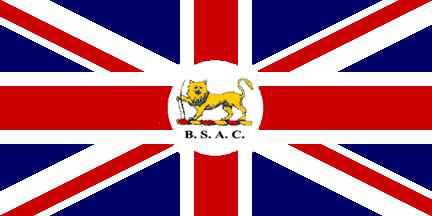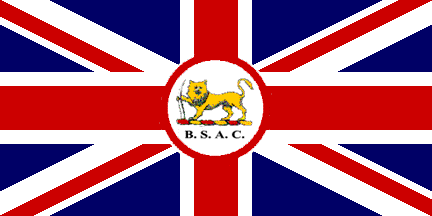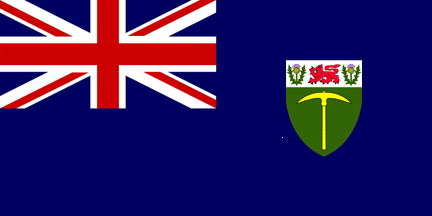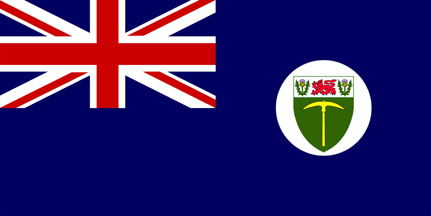 image by Martin Grieve, 18 Mar 2005
image by Martin Grieve, 18 Mar 2005
Last modified: 2005-09-17 by bruce berry
Keywords: rhodesia | southern rhodesia |
Links: FOTW homepage |
search |
disclaimer and copyright |
write us |
mirrors
 image by Martin Grieve, 18 Mar 2005
image by Martin Grieve, 18 Mar 2005
 image by Martin Grieve, 18 Mar 2005
image by Martin Grieve, 18 Mar 2005
The first flag of sovereignty flown in what is now Zimbabwe was the British Union Flag (Union Jack) raised at Fort Salisbury on 13 September 1890, which marked the beginning of prolonged British influence in the region. Instrumental in bringing European pioneers to the area was the 19th century British imperialist and financier, Cecil John Rhodes, whose British South African Company was later given prospecting and mining rights by the Matabele king, Lobengula. The Company's own flag had not been received from England when the Pioneer Column set out from South Africa, so a Union Jack was carried instead, the first company flag only arriving in Fort Salisbury in 1892.
The flag of the BSAC was raised in the Matabele capital of
Bulawayo
on 4 November 1893 after the Company's forces led by Major Patrick Forbes
drove the native Ndebele from the town. The flag consisted of a Union Jack
emblazoned with the BSAC badge in the centre (see BSAC
for a complete overview of flags used by the Company)
Bruce Berry, 18 June 1998
I did some research into the flags of the BSAC for a paper which I presented at the International Congress of Vexillology [brr99a] in Zurich in 1993. What emerges is that the Company flag hoisted at the occupation of Bulawayo, and presumably elsewhere in the area under Company jurisdiction, was not described in detail in the Charter. The flag was referred to as being a British Union Flag charged in the centre, on a white roundel, with the crest of the Company, namely a yellow lion "guardant passant" supporting with its right forepaw an ivory tusk which was known to the irreverent as the "lion with the tooth-pick". The lack of a precise description resulted in a number of design anomalies, the most obvious of which is the question of the presence of a red ring surrounding the crest in some cases and being absent in others (see illustrations above). Actual examples of both variants survive. Other less obvious differences relate to the lion and its features, these differences being attributed to the artistic licence of the manufacturers.
The end of the Company administration came following a referendum which was held in Southern Rhodesia. The referendum was held in October 1922 to determine whether the European settlers wished to join the Union of South Africa or become a self-governing Colony with 'Responsible Government'. The majority was in favour of the latter and consequently the administration of the BSA Company came to an end with the granting of Responsible Government to Southern Rhodesia by the British Government on 13 September 1923, while in April 1924 Northern Rhodesia became a British Protectorate. After being relieved of its political obligations, the Company continued to manage a wide range of agricultural, mining and commercial interests in both Southern and Northern Rhodesia until it amalgamated with the Anglo-American Corporation in 1965.
Between 1923 and 1965 the Company
continued to fly as a house flag, at its offices in London and the Rhodesias,
the flag it used whilst being the administrative authority.
Bruce Berry, 18 Mar 2005
 image by Clay Moss, 18 Jun 2005
image by Clay Moss, 18 Jun 2005
 image by Clay Moss, 18 Jun 2005
image by Clay Moss, 18 Jun 2005
Southern Rhodesia became a self-governing colony with responsible Government
in 1923, thereby relinquishing the
BSAC of its administrative
responsibilities. What this meant was that there was a local parliament although
some powers (notably relating to African political advancement) was retained
by London. The territory was ruled via the
Dominions Office (and NOT the Colonial Office) although strictly speaking
the country was not a Dominion (like Canada, Australia, South Africa etc.).
This was a unique case.
Bruce Berry, 20 Nov 1995
According to Bruce Berry's excellent account,
"Flying in the Winds
of Change, in The Flag Bulletin No. 163, March-April 1995 [brr95],
the status and usage of Southern Rhodesian flags from 1924-1937 was a bit
of a mess, to say the least! But it appears that Southern Rhodesia, when
it used the blue ensign at all, used the shield of the territory without
the white ring behind it, unlike other colonies. (For reasons which I'll
be outlining, Rhodesia was a constitutional anomaly; neither dominion nor
true colony). The two contemporary images I have are flatly contradictory - one
dated 1940 implies the circle, the other (c1937) doesn't.
Stuart Notholt, 11 Feb 1996
This is true, there was confusion surrounding the flag of Southern Rhodesia after the adoption of Responsible Government in 1923. When the organiser of the British Empire exhibition wrote to the Rhodesian High Commission in London in May 1925, on the question of the flag for the colony, this caused some consternation. The High Commission did not know what flag to use; on the advice of the Colonial Office, it recommended that the Blue Ensign with arms (or flag badge) in the fly be used, adding that the Governor had indicated that the government had approved the shield only as the flag badge. In March 1928 the Rhodesian High Commission wrote to the Colonial Office in Salisbury asking what the flag of the colony was, ad